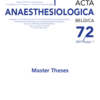Ultrasound-guided superficial cervical plexus block for post-herpetic neuralgia: narrative review of the literature and an illustrative case
Neuralgia; postherpetic; cervical plexus block; case report
Published online: Apr 21 2022
Abstract
Introduction: Post-herpetic neuralgia (PHN) is a common complication of reactivation of the varicella zoster virus. Treatment of PHN is often challenging with a myriad of medical and interventional treatments. We describe a patient with chronic facial PHN successfully treated with a single ultrasound-guided superficial cervical plexus block (SCPB) with local anaesthetics and corticosteroids.
Case report: A 47-year-old women presented with an intense PHN (NRS 8/10) on the left side of the face, ear and neck and concomitant symptoms of tinnitus and feeling of ear congestion for 1 year. Treatment attempts consisting of antibiotics, NSAIDs, nasal corticosteroids, physiotherapy, sertraline, lidocaine 5% patch and cervical facet injections proved to be inadequate.
Interventional treatment: After informed consent, ultrasound was used to inject 4 mL of ropivacaine 0.75% and 40 mg of methylprednisolon superficial to the deep cervical fascia and provided anesthesia of the anterior lateral neck, pre and retro auricular area and the clavicular area.
Results: A complete relief of symptoms was obtained for 2 weeks. After 6 weeks still 70% of symptoms subsided. Further treatment was not required. Treatment effect still persisted after 2 years (NRS1-2/10).
Conclusion: SCPB using ultrasound with local anesthetics and corticosteroids can be considered for facial PHN.
